What is a Circulating Pump?
The circulation pump is a very important part of your central heating system.
It is recommended to be aware of its role as well as common troubleshooting problems that could occur, so as to ensure it is doing its job properly.
We shall discuss key aspects relating to this important component of a central heating system in more detail below.
Article Chapters
What is a Circulator Pump?
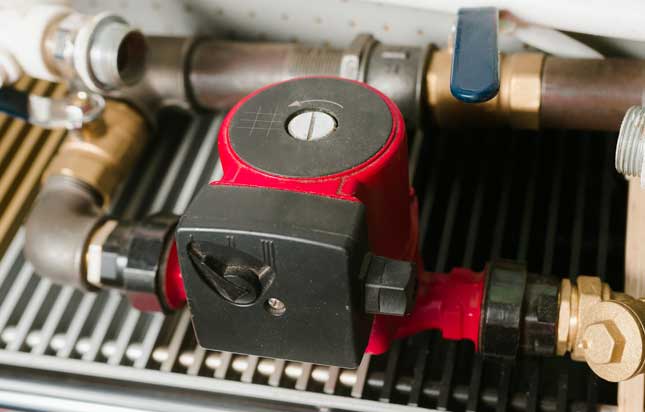
Image source: Shutterstock
A circulating pump is a water booster pump which has the role of moving hot water around the heating system.
The water will travel from the boiler through pipes which feed into various appliances, such as hot water cylinders, radiators and towel rails.
Then, the water will flow back to the boiler, thus ensuring that there is a constant flow of heated water maintained throughout the building.
The central heating circulator pumps are generally located near the boiler, inside it, or in the airing cupboard near the hot water cylinder.
Circulating pumps come in various shapes and sizes.
Such pumps are inline centrifugal pumps, that is, the inlet and outlet are aligned.
Thus the water moves by means of centrifugal forces.
Where Are They Used?
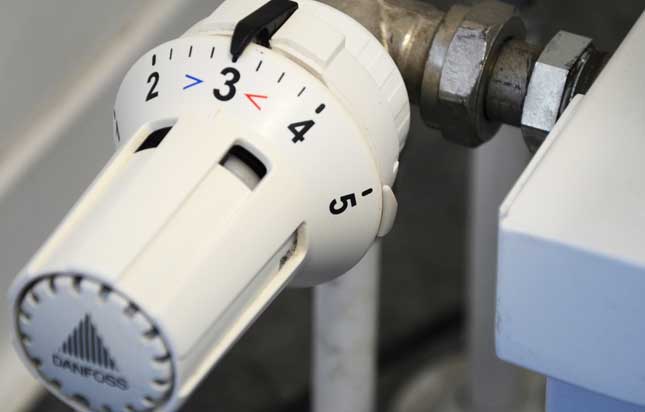
Image source: Pixabay
Circulating pumps are found in central heating systems in homes, residential property and offices.
Their job is to increase water pressure around a heated water circuit, thereby ensuring that whenever a tap is turned on hot water will be almost instantly supplied.
Otherwise without such a pump one would need to wait for the hot water to flow through the entire system till it reaches that tap.
Such pumps are also used in hydronic heating systems.
Their role in such a case is to circulate the heated water between the boiler and heat exchangers, such as radiators.
Circulating pumps are also used in larger heating systems in order to supply heat to various parts or zones in a building.
Main Components of a Circulating Pump
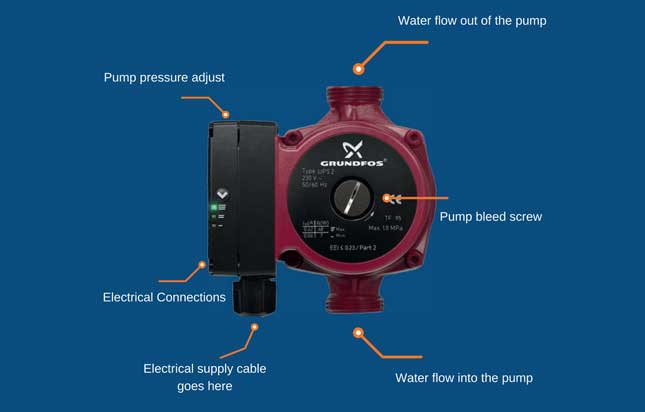
Image source: Anchor Pumps
A circulating pump is made up of two main parts, namely the pump and the motor.
However there are various other important parts and components.
The motor, in this case, is an induction type which allows the conversion of electrical energy into mechanical energy.
The latter is then used to drive the pump and consequently, the water is moved.
A circulating pump will have an inlet and an outlet.
The pump pulls the water in through the inlet, and then pushes it out from the outlet.
On the casing you should see an arrow which shows the direction of the flow.
This will demonstrate which is the inlet and which is the outlet.
The inlet and outlet are aligned concentrically.
Since this type of pump is a centrifugal pump, the water needs to enter through the eye of the impeller.
For this reason the inlet follows a path which sweeps around into the impeller.
This is the pump casing, which has a channel within it known as the volute.
Once the water goes out from the impeller it will collect in the volute, and then move out of the outlet.
The impeller sits within the pump casing and it is surrounded by the volute channel.
When the impeller rotates, it will impart a centrifugal force and as a result the water will be pushed out of the pump and make its way into the pipes.
Right behind the impeller there is the backplate, which acts as a barrier.
Its role is basically to keep the flow of the water within the pump case.
The backplate is also responsible for holding one of the bearings for the shaft and thus ensures smooth rotation is possible.
Leaks are prevented by means of a rubber seal.
Then, there is the shaft and the rotor.
The latter is attached to the former.
The shaft is also attached to the impeller, so that when the rotor rotates, so will the shaft and the impeller.
The rotor is situated in the rotor can, which acts as a barrier so that the water does not come in contact with the electrical circuits of the motor.
Indeed, the inductor motor of a circulating pump is made up of a number of coils of copper wire.
These are tightly packed into the stator.
Neither the coils nor the stator rotate, but when electricity flows through the coils, it will create a rotating electromagnetic field, which in turn makes the rotor turn.
The motor housing will protect these, and right on the side there will be an electrical terminal box, where there is the speed selector switch.
This is used to manually select the speed with which the motor rotates, thereby changing the flow rate of the circulator pump.
How Does a Circulating Pump Work?
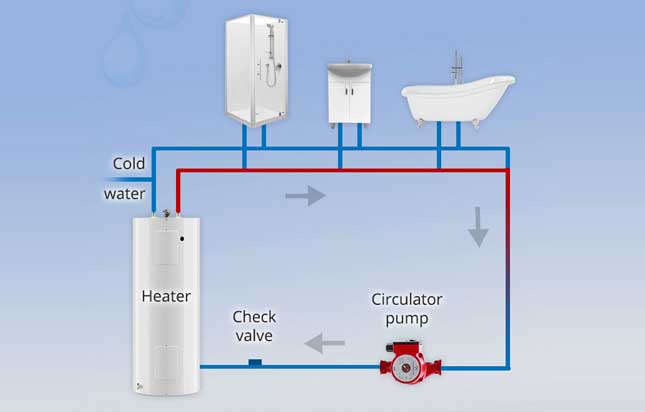
Image source: Bola Systems
A circulating pump works as follows:
- Water enters the pump through the inlet, and makes its way in the eye of the impeller, where it gets trapped in between the impeller’s blades.
- A rotating magnetic field forces the rotor to start spinning.
- Since this rotor is attached to the shaft, which in turn is connected to the impeller, they will also start to rotate. This results in kinetic energy in the water, which will start to move out.
- As soon as the water reaches the edge of the impeller the velocity rate will be very high. It then goes into the volute, and impacts the pump casing’s wall. This impact results in pressure.
- The flow rate will depend on this level of pressure. The volute’s diameter will expand, resulting in the water velocity to decrease, and so the pressure increases.
- If there is a higher pressure at the outlet, more water is forced to circulate through the pipes, to where it is needed.
Reasons Why Your Circulating Pump Isn’t Working
There could be a number of reasons why your circulating pump might be troubleshooting.
Some of the most common indications that there is something wrong with your circulating pump include:
- There could be a water leak
- You might have no hot water
- Some radiators, or all of them, may not be heating up
- The pump might be making strange noises
- You may notice that the pump casing feels rather hot
- On the other hand you might notice that even though the pump is running, the water flow pipe is not hot.
Such problems might be caused from blockages or as a result of an airlock in the system.
However there could be more serious reasons, and hence it is best to have a professional check your circulating pump so as to verify what the problem is, and repair it accordingly.
Common Circulating Pump Problems & Remedies
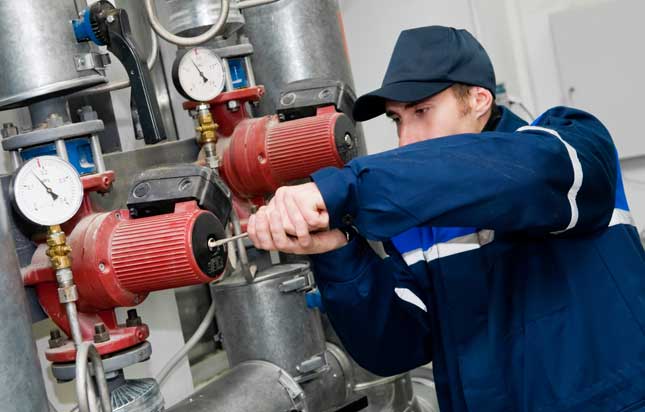
Image source: Shutterstock
The following are some of the most common circulating pump problems, accompanied by some tips and methods for repairing or resolving them.
Noisy Pump
Often circulating pumps make unusual noises simply because there is an airlock in the pump.
To resolve this, turn off the pump’s electrical supply, and turn the small bleed screw on the pump using a screwdriver so as to allow any air to escape.
Make sure to place a towel or cloth underneath as the pump will be full of water.
Unscrewing this screw a little bit should suffice.
Once you are done, retighten it and turn the electrical supply back on.
If the noise you noticed previously is gone then it was truly due to an airlock.
Otherwise, you may wish to consult a professional as another possible reason for strange noises could be because a bearing in the pump might have come loose, or there might be a separate issue with the boiler.
Blocked Pump
Another common problem is that the pump might have become blocked.
An indication of this is that the heating is taking a while to reach the full temperature, or it is not heating up at all.
A blocked pump might result due to a buildup of sludge and sometimes metallic particles.
Such dirt could easily get stuck in the pump’s components.
A professional will verify this and if necessary carry out a system cleanse to solve the problem.
Leaking Pump
If you have noticed any water leaking from the pump, chances are that the pump worked itself loose, or else there is a blown seal.
Try to solve the leaking problem by tightening up all the joints with a spanner or wrench.
Check all the fittings to see if there are any parts which seem to be corroded.
You may also wish to check the joint on the pump as the leak might be resulting from there.
In such a case the seal may need to be replaced.
No Water Running Through the System
Should your circulating pump run but you can see that there is no water running around the system, then the shaft or the propeller are probably stuck.
Sometimes, tapping on the pump will help to free up any stuck components.
But if this problem is taking place often it is best to have a professional check it out.
Radiators Not Heating Up
You may wish to check if there is a problem with the speed and flow.
If these are adjustable, then the settings may need to be readjusted.
Electrical Problems
There could be a problem with the electrical wiring.
The pump may be losing power, and in that case a specialist should check it out.
Cost of Replacing a Circulating Pump
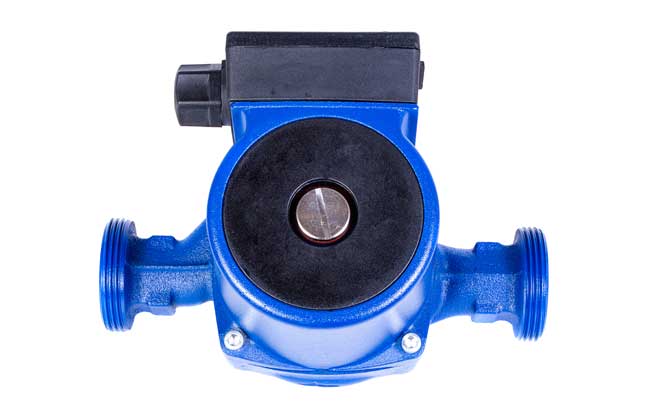
Image source: Shutterstock
Replacing a circulating pump is something you may need to do from time to time.
This will depend on the condition of your pump, as well as on the types of issues that you have been experiencing.
Sometimes certain problems may not be worth repairing.
For instance, if the pump is rather old, or there are parts which are corroded, it will probably not be cost effective to repair it.
In such cases it is best to replace the pump with a new one.
As a general rule, if the pump is less than 5 years old you will be entitled to a replacement under warranty.
The cost of replacing a circulation pump will depend on the type of pump you need.
There may be certain specifications that you will need to take into account when buying a replacement, such as the speed and the flow rate required.
Circulating pumps’ prices vary according to the brand you opt for too.
Most will cost between £90 and £160.
You may also need to factor in additional installation costs, which could be in the range of £150 and £300.
Conclusion
The circulator pump is a key part of your heating system.
A general understanding of how it works and the components that it is made from will allow you to be aware of any problems that might be present, so that you can act promptly and properly.
While some issues may be minor, more serious ones are best left in the hands of a professional.
If you have issues with water circulation or pressure in your building’s heating systems, contact KD Pumps for help today.

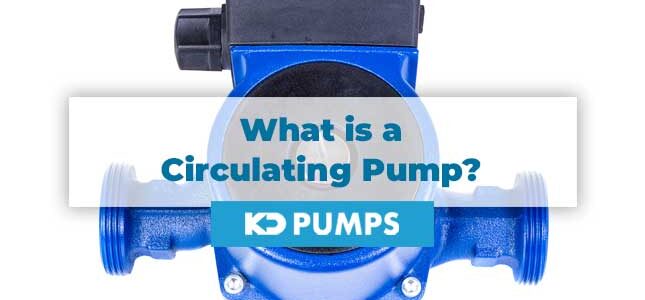
Comments are closed.